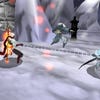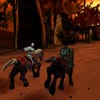Shinobi Review
Shadow dancing.
Some games age well, and some just age; take a look at Shinobi. The 1987 arcade game and its home console sequels are, in the memory, death-defying adventures through samurai death mazes, a precision gauntlet. But these days, Shinobi plays worse than the memory. It feels like an archaism rather than a forerunner.
Perhaps that undersells a series that has seen 12 (!) entries, including this kind-of-reboot for 3DS by Griptonite Games. Shinobi has dabbled in full 3D combat with the highly fiddly PS2 games, but here the depth is purely visual. This is a 2D platformer that wants nothing more than to hit the nostalgia button.
That's not to say the illusion isn't good. Shinobi's action may be 2D, but its locations have a depth of scenery and a neat eye for angle-turning tricks that, even now, is sadly uncommon on 3DS. The crisp cartoon reworkings of the 16-bit enemies jump out on these stages, lending the violent animations real hoof.
This man-to-man combat is what Shinobi 3DS does best. But what it does most is flutter around it, prioritising repetitive platforming and boring distance combat over what proves to be its only real strength. It's clearly intended as a kind of homage to the years of Shinobi 3, from the reworked blocking mechanic to a rather dated (and repeated) Teenage Mutant Ninja Turtles gag.
Up close, it can work brilliantly: fast, fluid slices through enemy after enemy with perfect blocks leading to devastating counters. The parry is a quick press of the 'R' shoulder button, which you can remap to another button for preference, and which deflects incoming attacks in a generous timing window. In straight fights, it's a clinical and satisfying tool, a trigger that lends a Zen-like calm to the most frenetic encounters.
But the further Shinobi gets, the more it messes things up. A defining characteristic of the series, and one this game clearly aspires to, is a stiff challenge. But a stiff challenge is not always the same as a fair challenge, especially when mixed with unnecessarily stingy checkpointing.
You will rarely die from combat in Shinobi; instead, your allegedly universe-conquering ninja will fall soundlessly to his death, again and again. This is not a game built for platforming, but there is an awful lot of platforming - most of which, it has to be said, seems to be re-textured from a bare few templates.
Shinobi's leap has more vertical lift than horizontal movement, so despite a double-jump that rescues some situations, the platforming is a series of misjudgements waiting to happen. The momentum of the character is never quite right for these intricate timing tests, and the wall-jump proves quite the trick to master, but you can just about learn to fudge through.
Until the later levels, that is, where it seems most jumps come with a free henchman waiting to knock you into the pit o' doom. It becomes almost comical how cheap this gets. Shinobi's stages are split up into anything from three to five sizeable sections, for which you have five lives on Normal difficulty - a continue puts you back at the start of the gauntlet. As frustrating as the platforming is, and it is very frustrating indeed, this constant replaying of previously cleared sections is the real twist of the knife.
It makes clear how rote everything about Shinobi's design is: what you first play as trial-and-error quickly becomes a game of Simon Says - jump here, throw there, parry now. Shinobi's combat is quick and changeable enough to remain enjoyable, but next to something like The Dishwasher this is simple fare indeed - combos are a matter of mashing the same button, stealth kills are entirely scripted, and the magic system is an afterthought.
Certain sequences move away from the core 2D play, typically featuring Shinobi riding something fast into the screen. There's an undeniable visual flair on show here, but despite trying various levels of the 3D effect the precise positioning of pickups always seems elusive - which seems to rather argue against the whole idea of 3D. Irrespective of that, these sections are a trudge: the archetypal vehicle section, once played and soon forgotten.
All that keeps your interest is the combat, where the sword's cuts and slices have real heft and timing those parries adds a welcome layer of strategy. But it's a system too often hemmed in by overly scripted level design. Progression works out more like a step-by-step puzzle than a brawl, with enemy positions memorised and neutered over continues and continues of play.
The same goes for Shinobi's otherwise neat Streetpass idea: unlockable challenge levels. These become available as you pass other Shinobi players or cash in play coins, and are courses that demand a very linear set of actions to complete, during which one hit will kill you. It all begins to feel rather punitive.
But perhaps I am a yellow-bellied lily-fingered pantywaist. If Shinobi is channelling the spirit of its simpler forebears, part of that is this uncompromising stance towards the player: learn to execute perfectly on these obstacle courses, or fail. You can call it the Mega Man philosophy, and it's clearly behind the challenge here.
If you enjoy replaying previously completed sections because of an annoying platforming bit later on; if you enjoy being surprised by cheap enemies; if you enjoy memorising attack patterns that never show a hint of imagination; if you enjoy a game built around jumping precision with just-ever-so-slightly wonky controls - then you'll enjoy Shinobi, and be a man my son.
But is it enough to make an old series feel exciting again? Shinobi may have fancy visuals and more than a few neat 3D tricks, but the design underpinning it is archaic, like the last 20 years of 2D platformers never happened. Even on these terms, an equivalent as old as Super Probotector has 10 times the ideas on show here. To call this a bad game would be grossly unfair, but it's a truly unexceptional one. For a series like Shinobi, that is dishonour enough.














